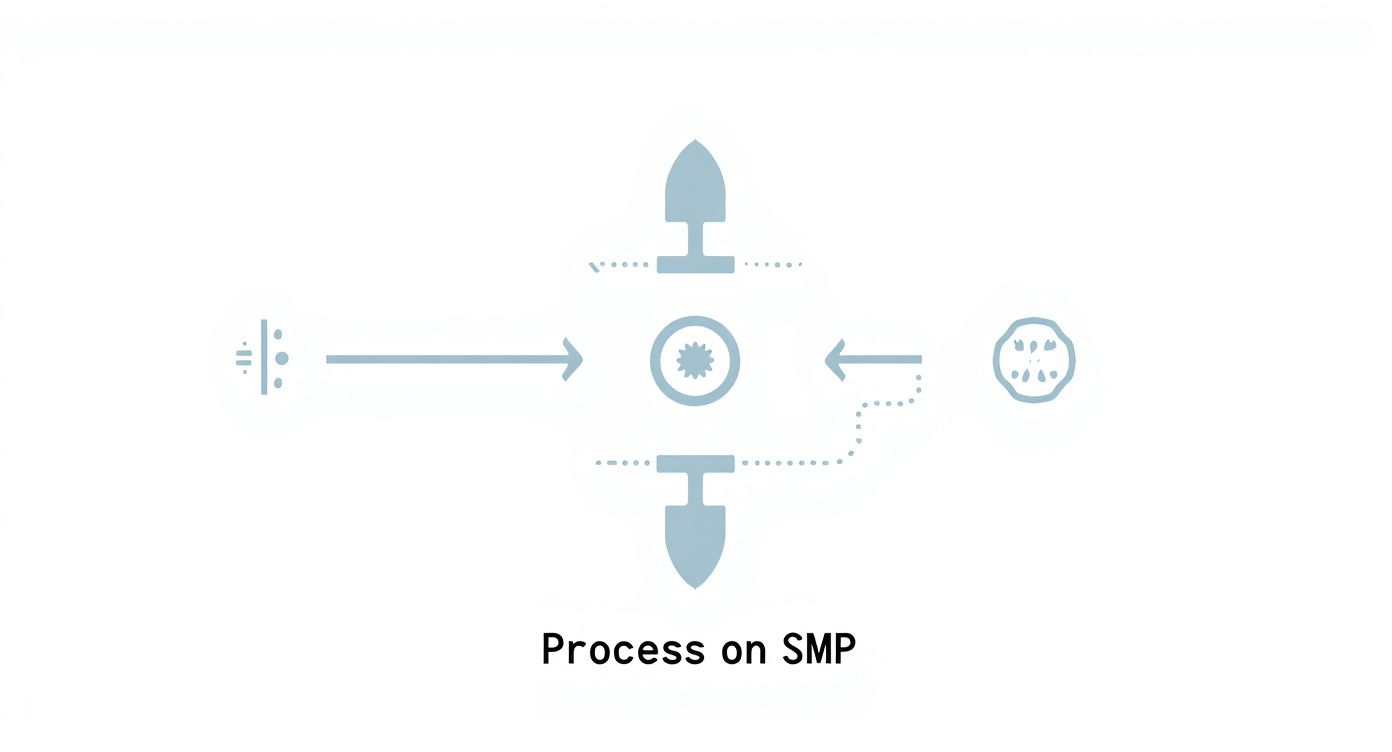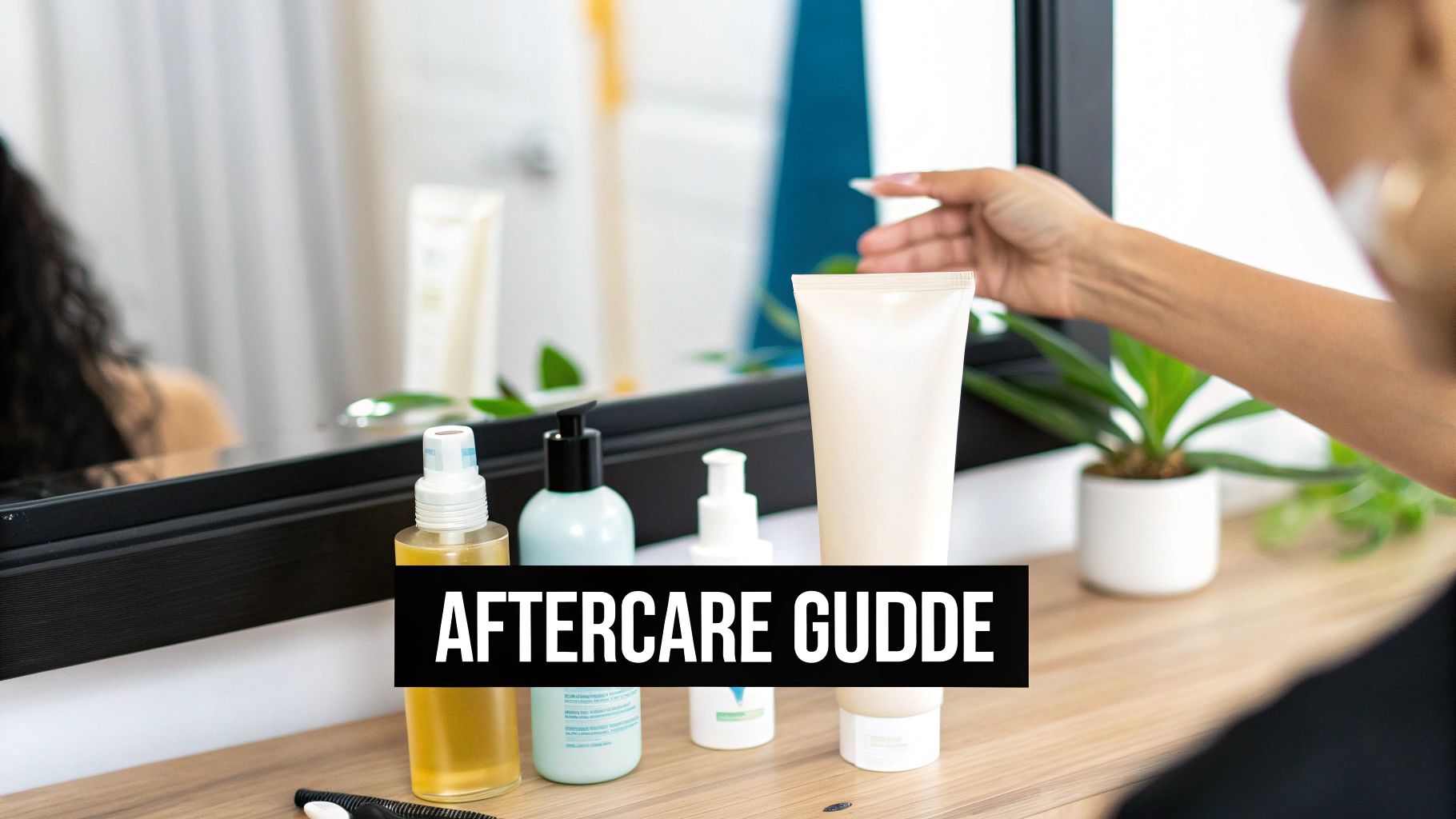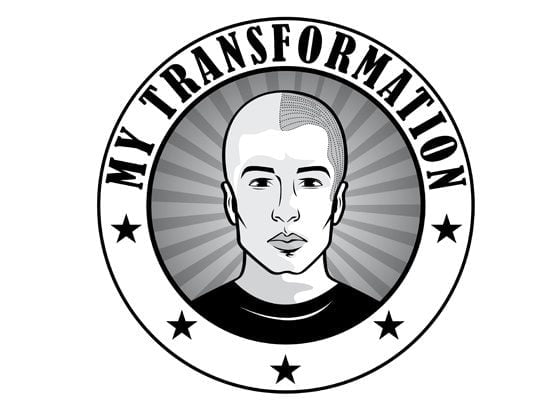
what is a bald head tattoo? SMP Guide for Bold Confidence
Share
So, what exactly is a 'bald head tattoo'? It's not the kind of ink you'd get at a typical tattoo parlour. We're talking about a highly specialised cosmetic procedure known as Scalp Micropigmentation, or SMP for short.
Using micro-needles, a trained technician deposits thousands of tiny pigment dots into the upper layer of your scalp. These dots are layered meticulously to replicate the look of individual hair follicles, creating a flawless illusion of a full head of hair with a sharp, buzz-cut style.
How Does A Hair Tattoo Actually Work?
At its heart, SMP is an incredibly effective way to tackle hair loss by restoring the appearance of density. It’s a world away from traditional tattooing, which uses larger needles to penetrate deeper and create solid lines or shading.
SMP is all about subtlety and precision. Technicians use incredibly fine needles to create thousands of micro-impressions, building up layers of 'stubble' that look completely natural. The goal isn't to draw a picture, but to rebuild the visual frame of a hairline and give the impression of a closely shaved head.
The key objectives are to:
- Create the convincing look of a full buzz-cut on a bald or balding head.
- Add visual density to thinning areas, minimising the noticeable contrast between the scalp and existing hair.
- Expertly camouflage scars from injuries or hair transplant surgeries.
This procedure is a genuine game-changer for so many people. It’s not about magic hair regrowth; it's about taking back control and getting the look you want with immediate, hassle-free results. For a closer look at the nuts and bolts, check out our detailed guide on what scalp micropigmentation involves.
Here in Australia, SMP has become one of the go-to solutions for hair loss, especially for men. When you consider that male pattern baldness affects about two-thirds of Aussie blokes by the time they hit 35, it’s easy to see why. SMP offers a reliable, aesthetic fix that fits perfectly with an active lifestyle—no more messy powders or temporary concealers.
Your Step-by-Step SMP Journey
Getting a Scalp Micropigmentation (SMP) treatment isn't like walking into a regular tattoo parlour. Think of it more like commissioning a custom piece of art for your scalp. It's a meticulous, multi-step process that’s all about creating an incredibly realistic result.
Everything kicks off with a detailed consultation. Honestly, this is probably the most important part of the whole journey, as it lays the groundwork for your final look. You'll sit down with a specialist and map out your perfect hairline, taking into account your face shape, age, and what you're comfortable with. You’ll also nail down the right pigment shade to ensure a seamless match with any existing hair and your skin tone.
The Multi-Session Approach
One of the biggest differences between SMP and a traditional tattoo is that it’s never a one-and-done deal. The secret to that hyper-realistic, 'I just shaved my head' look is building it up gradually over several sessions.
Most people need between two to four sessions to get the job done right, with about 10-20 days between each appointment to let everything heal and settle.
This layered approach is completely intentional, and it's what makes the result so convincing. Here’s why:
- Building Natural Density: Your first session is all about creating the base layer and establishing your hairline. The follow-up sessions are for carefully adding more pigment dots between the first ones, which creates that illusion of a full, dense head of hair.
- Creating Depth and Tone: Real hair isn't one flat colour. A skilled technician might use slightly different pigment shades in later sessions to mimic the subtle, multi-tonal look of natural hair follicles.
- Perfecting the Look: Giving your scalp time to heal between appointments lets the pigment settle properly. It also gives you and the technician a chance to assess the progress and make any small tweaks needed for a flawless finish.
This infographic gives you a great visual on how the SMP application works.

As you can see, it breaks down how specialised pigments and micro-needles are used to create tiny impressions that look just like real hair follicles, which is the foundation of the bald head tattoo.
What Happens During a Session?
You can expect each session to last anywhere from two to five hours, depending on how much area needs to be covered. The technician uses a purpose-built digital machine with a super-fine needle to place the pigment into the upper layer of your scalp’s skin.
This is much shallower than a standard tattoo, which is why it's generally less painful and allows for such crisp, precise results. If you want a deep dive into every stage, check out our guide on the full process of getting a hair tattoo.
At its core, SMP is a process of refinement. Each session builds on the last, letting the artist perfect the density, blend the colour, and make sure the final result is impossible to tell apart from a real buzz cut.
The good news is that this meticulous work is surprisingly accessible. For a full scalp treatment, the cost typically falls between AUD 1,500 and 4,000. The final price depends on the size of the area being treated and the clinic’s level of expertise, making SMP a truly realistic option for Aussies looking to regain their confidence.
Is a Bald Head Tattoo Right for You?
Thinking about getting a bald head tattoo, or what we in the industry call Scalp Micropigmentation (SMP), is a pretty big decision. The results can be absolutely life-changing, but it's vital to make sure the whole process lines up with what you're looking for, your lifestyle, and your hair loss situation. SMP isn't some magic bullet for everyone, but for the right person, it truly is a game-changer.
This isn't just about covering up bald spots. It's about meticulously crafting a look that brings back your confidence and makes your morning routine a whole lot simpler.
Ideal Candidates for SMP
So, who really gets the most out of this treatment? You're probably a perfect fit if you see yourself in any of these scenarios:
- Men with Male Pattern Baldness: If you've got a receding hairline or a thinning crown and you like the idea of a sharp, clean buzz-cut look, then SMP was practically made for you. It builds a strong, totally natural-looking hairline and gives the brilliant illusion of a full head of hair that’s just been shaved.
- Individuals with Alopecia: For anyone dealing with alopecia areata, which causes those frustrating patches of hair loss, SMP can expertly fill in the gaps for a much more uniform look. It's also an incredible solution for creating the appearance of full density if you have alopecia totalis.
- People with Scars: SMP is fantastic for camouflaging scars on the scalp. Whether they’re from an old injury or a previous hair transplant surgery (like FUE or FUT), the pigment is brilliant at concealing the scar tissue, making it blend right in with the rest of your scalp.
- Women with Thinning Hair: Women who are noticing diffuse thinning can also see huge benefits. By carefully placing pigment between the existing hairs, SMP dials down the contrast between the hair and the scalp, which creates a look of much greater thickness and density. You can find a more detailed breakdown in our guide on who can benefit from hair tattoos.
When to Reconsider or Postpone SMP
On the flip side, SMP isn't always the best immediate path for everyone. It's really important to be honest about the situations where you might need to press pause.
You may need to hold off on treatment if you have:
- Active Scalp Conditions: If you're dealing with severe dandruff, psoriasis, or eczema on your scalp, you’ll need to get those conditions under control first. An inflamed or flaky scalp just won't heal properly after the procedure, which will compromise your results.
- A Tendency for Keloid Scarring: Anyone who knows they are prone to developing keloids (those raised, overgrown scars) needs to be very careful with SMP. The tiny punctures from the needles could potentially trigger a keloid to form.
- Unrealistic Expectations: It’s crucial to remember that SMP creates the illusion of hair follicles – it’s a 2D effect, not real, 3D hair. Getting your head around this fact is the key to being genuinely happy with the final result.
The real beauty of SMP lies in how adaptable it is. A skilled technician can completely customise the treatment, working with you to choose the perfect shades and density to match your natural hair colour and desired style. This ensures the final look is 100% yours. You can discover more insights about the rise of cosmetic tattooing in Australia on mccrindle.com.au.
Weighing the Benefits and Potential Risks

Getting a bald head tattoo is a big decision, so it's smart to look at it from all angles. Like any cosmetic treatment, Scalp Micropigmentation has its upsides and its potential downsides. Getting your head around both is the key to making a choice you'll feel great about for years to come.
On one hand, the benefits can be absolutely life-changing, offering a fast, effective solution for hair loss. On the other, you need to be realistic about the risks and what’s involved. Let’s dive in and break down exactly what you need to consider.
The Powerful Benefits of SMP
One of the biggest draws for SMP is how quickly you see a difference. There’s no waiting around for months, wondering if a treatment is working. You walk out of your final session with a finished look. It's instant.
But it’s not just about the immediate result. The practical, day-to-day advantages are what really win people over.
- Virtually Zero Daily Maintenance: Forget about messy hair fibres or special styling products. Once your SMP is fully healed, it’s completely hassle-free. It’s a true wash-and-go solution that gives you back time and headspace.
- A Long-Term, Reliable Solution: SMP is built to last. It won't wash off in the rain or get messed up by the wind. While you might need a refresh every 4 to 6 years to keep it looking sharp, it’s a consistent look you can rely on every single day.
- Cost-Effective Over Time: The initial cost is a one-off investment. When you compare that to the endless expense of hair systems, medications, or topical treatments that you have to keep buying, SMP often works out to be much more affordable in the long run. We explore the many benefits of getting a scalp tattoo in more detail right here.
Honestly, though, the biggest change we see in our clients is the confidence boost. So many people talk about the relief of not having to worry about their hair loss anymore. That feeling is often the most valuable part of the whole experience.
Understanding the Potential Downsides
Alright, let's talk about the other side of the coin. To make a properly informed decision, you need to know about the potential risks. While SMP is overwhelmingly safe with a good technician, it's not without things to consider.
The single most important factor in avoiding risks is your choice of technician. An inexperienced practitioner can lead to unnatural-looking results, such as a hairline that is too harsh, dots that are too large, or pigment that turns blue over time.
Here are the main things to keep in mind:
- Pigment Fading: The sun is the number one enemy of any pigment. If you're not disciplined with a high-SPF sunscreen on your scalp, the treatment can fade faster than it should, meaning you'll need touch-ups sooner.
- The Need for a Skilled Artist: Your result is 100% dependent on the skill of your technician. A bad job is hard and expensive to fix, so doing your homework on an artist's portfolio, experience, and reviews is an absolute must.
- Minor Side Effects: As with any procedure that breaks the skin, there's a small risk of infection if you don't follow the aftercare instructions perfectly. Allergic reactions to the pigment are very rare, but they are a possibility.
To help you see it all at a glance, we've put together a simple table weighing up the pros and cons.
Pros and Cons of Scalp Micropigmentation
| Advantages | Potential Disadvantages |
|---|---|
| Instant, visible results after final session | Fading can occur without proper sun protection |
| Extremely low daily maintenance | The final result is highly dependent on artist skill |
| A long-lasting solution for hair loss | Risk of minor infection if aftercare is ignored |
| Creates the look of a full, shaved head | Bad SMP is difficult and costly to remove or correct |
| Can camouflage scars and conceal thinning | Allergic reactions to pigment are rare but possible |
| Boosts confidence and self-esteem | A semi-permanent decision requiring careful thought |
| More affordable long-term than other solutions | May require a touch-up session every 4-6 years |
Ultimately, for most people who choose a reputable artist, the advantages of SMP far outweigh the potential drawbacks, which can largely be avoided with proper research and care.
Protecting Your Investment With Proper Aftercare

Walking out of your final Scalp Micropigmentation session feels incredible, but remember, the technician’s job is only half the battle. Now, it's up to you. The real secret to keeping your new look sharp, defined, and vibrant for years to come is all in the aftercare. Think of it like a brand-new painting – a little protection goes a very long way.
Those first few days are absolutely crucial. Your scalp is healing, and your main job is to give the pigment the best possible chance to settle in perfectly. This means following a few simple but non-negotiable rules.
For the first three to four days, it is essential to keep your scalp completely dry. That means no showering (unless you can keep your head out of the water), no swimming, and definitely no saunas or steam rooms. You’ll also want to avoid any intense workouts that make you sweat heavily, as moisture is the enemy of fresh pigment.
Immediate Aftercare: The First Week
During this initial healing phase, your mission is to leave your scalp alone. The tiny micro-wounds created during the procedure need time to close up and lock in that pigment for good.
- No Water, No Sweat: As we mentioned, keep your head dry for those first few days. It's the most important rule.
- Hands Off: Your scalp will likely feel a bit itchy as it heals, which is totally normal. But you have to resist the urge to scratch, pick, or rub it. Doing so can pull the pigment right out and leave you with patchy spots.
- Stay Out of the Sun: Direct sunlight is a big no-no for a fresh treatment. If you have to be outside, wear a loose, clean hat. UV rays are the fastest way to fade new pigment.
Proper aftercare isn't just a friendly suggestion—it’s a mandatory part of the process. How you look after your scalp in this first week will directly determine how good your SMP looks for the long haul. For a full breakdown, have a look at our detailed guide on scalp micropigmentation aftercare.
Long-Term Care and Maintenance
After about a week, once your scalp is fully healed, your focus will shift from healing to simple, ongoing maintenance. This is all about building easy habits that keep your SMP looking as fresh as the day you got it.
Your number one priority? Sun protection. UV radiation from the sun is the main culprit behind fading pigment. It breaks it down over time, making your look appear washed out. Get into the habit of applying a high-SPF, broad-spectrum sunscreen (at least SPF 30+) to your scalp every single day.
Keeping your scalp moisturised is also key. A good-quality, light moisturiser applied daily will keep the skin healthy and the pigment looking bold and clear. It prevents the kind of dryness and flaking that can make even the best SMP look dull. The beauty of SMP is that it’s a non-invasive treatment with very little downtime, offering a lasting solution that’s much easier to maintain than other hair loss treatments.
Your Top Questions About SMP Answered
Even with all the details covered, you've probably still got a few practical questions rattling around in your head. That's perfectly normal. Getting a bald head tattoo is a big decision, and you want to feel confident about every aspect.
Let's clear up those last few uncertainties. Think of this as a straightforward chat where we tackle the common queries we hear every day, from how it feels to how it ages.
Does Getting a Bald Head Tattoo Hurt?
Honestly, most clients are surprised at how manageable it is. People usually describe the sensation as a light, repetitive tapping or a minor irritation, not real pain. If you were to put it on a scale from 1 to 10, the vast majority rate it somewhere between a 2 and 4.
The reason it's so tolerable is that Scalp Micropigmentation uses incredibly fine needles that only just break the surface of the skin—much shallower than a regular tattoo. On top of that, we always apply a quality topical numbing cream before we start, which takes the edge off and keeps you comfortable from beginning to end.
How Long Does a Bald Head Tattoo Last?
SMP is designed to be a long-term solution, but it's best to think of it as semi-permanent rather than forever. The pigment will naturally soften and lighten over time, which is actually a good thing as it helps it age gracefully with you.
The two main culprits for fading are sun exposure (your biggest enemy!) and your body's immune system doing its job. You can realistically expect your results to look crisp and defined for 4 to 6 years. After that, a quick one-session touch-up is usually all it takes to bring back the depth and have it looking brand new again.
Can I Grow My Hair Out After SMP?
Absolutely. One of the best things about SMP is that it doesn't affect your hair follicles in any way. The pigment is placed in the upper dermis, well away from where your hair actually grows, so it won’t interfere with its natural cycle.
In fact, many of our clients who have diffuse thinning choose to keep their hair a bit longer. The SMP treatment creates a brilliant shadow effect on the scalp, which massively dials down the contrast between the hair and skin. The result is a powerful illusion of thicker, fuller hair.
And if you’ve had the buzz-cut look and decide to grow it out later? No problem. The SMP will simply be hidden underneath.
It's worth remembering that SMP is a two-dimensional illusion. Up close, especially to the touch, it won't feel like real hair stubble. But from a normal, everyday social distance, the effect is incredibly convincing and realistic.
What Happens When My Hair Turns Grey?
This is a fantastic question and one that every skilled SMP artist has a plan for. We never, ever use a straight black pigment. A true artist works with a palette of charcoal and grey-based pigments.
From there, we custom-mix and dilute the shade to get an exact match for your specific hair colour and skin tone. As your hair naturally starts to go grey, the SMP is already designed to blend right in. The pigment also lightens subtly over the years, which helps it evolve perfectly with your natural ageing process, ensuring your look stays completely authentic.
Ready to see what Scalp Micropigmentation could do for you? At My Transformation, Michael is dedicated to helping you find the perfect hair loss solution. Visit us today to book your free consultation!
